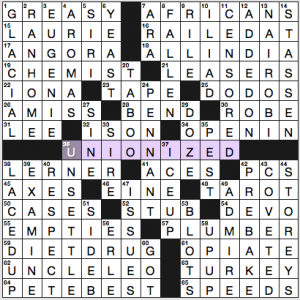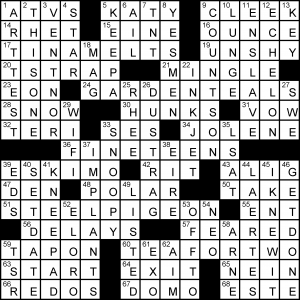 (3.50 avg; 5 ratings) rate it
(3.50 avg; 5 ratings) rate it
 (3.70 avg; 15 ratings) rate it
(3.70 avg; 15 ratings) rate it
 (3.67 avg; 33 ratings) rate it
(3.67 avg; 33 ratings) rate it
Matt Ginsberg’s New York Times crossword—Amy’s write-up
I knew there would be some sort of theme or gimmick here, because Matt doesn’t make plain crosswords. (He could use his computing power to generate great themelesses, but doesn’t because where’s the fun in that?) We’ve got a CHEMIST and a PLUMBER clued as people who might pronounce 36a: UNIONIZED with 4 vs. 3 syllables—un-ionized vs. union-ized. There are lots of people besides PLUMBERs whose first instinct would be the “union” version of the word. Nice pair of heteronyms.
This puzzle took me longer than most Friday NYTs, which is not a complaint. A 72-worder with 23 theme squares and four wide-open corners with largely solid fill? I’ll take it.
Five more things:
- 18a. [Subcontinent-wide], ALL-INDIA. Not sure I’ve seen this term before, but then, I’ve never been to India.
- 62a. [Lesser “Seinfeld” role played by Len Lesser], UNCLE LEO. “Jerry. Hello.” I like the “Lesser” two-fer.
- 5d. [When told “I’m sleepy,” she sometimes says “I hope you’re not driving”], SIRI. I’m sleepy but I’m not driving, just blogging. 29d. [Nap], DOZE? No, thanks. I’ll just settle in for the night.
- 33d. [Top of the line?], SIRE? Not always. The top of 3-Down EUGENIE‘s line is her grandma, Elizabeth II. (Eugenie is 8th in line. I don’t think she’s gonna get the nod.)
- 40d. [Word repeatedly spelled out by Franklin], RESPECT. Good one! Aretha, the Queen of Soul, and not Benjamin, the Tempter of Lightning.
A couple little bits of heavy-in-crosswords fill like ERLE and ARA—but really that’s it, which is pretty darn good for a 72-worder with 23 theme squares. 4.2 stars from me.
Sam Donaldson’s LA Times crossword – Gareth’s write-up
I assisted another constructor on this very theme, but despite extensive revisions it never really came together. Rich rejected our version in 2014 on the basis of the theme entries. I’m happy to see that a TEAFORTWO puzzle did finally see daylight. Well done, Sam! It’s deceptively restrictive in the changes that are available!
- [What Fey does in a mushy moment?], TINAMELTS.
- [Ornamental ducks?], GARDENTEALS.
- [Model high schoolers?], FINETEENS.
- [Park statue that might have the real things perched on it?], STEELPIGEON. Phew! That’s a convoluted clue!
- [“No, No, Nanette” song…], TEAFORTWO
Remarks:
- [Two-iron, before golf club numbering], CLEEK. Obscure vocab, though the crossers are fair.
- [Orator’s prowess: Abbr.], RHET. It’s in the dictionaries, though I can’t fathom an occasion when one would use it.
- [Selective words], THISONE. I presume the McCartney single didn’t chart so well State-side then?
Not too much more I’d like to say.
Gareth out.


NYT: good one!
Except I don’t love the clue for OPIATE
Started off easy but I had trouble finishing, mostly because it took me a long time to see and understand the theme answers. Isn’t it at least arguable that plumbers and others say UNIONIZED with four syllables? You-knee-uhn-ized?
I think I’ve said this before, but I don’t like the idea that SINE ‘makes’ a wave — SINE describes a certain kind of mathematical wave. What makes the wave could be gravity or springs or…
Isn’t it TABOO to have LACEDUP and ICEUP in the same puzzle?
Talking of which, if it’s TABOO for a Jew to shave with a razor, how do clean-shaven Jews get rid their stubble?
The SINE clue is a little clunky, but the graph of the sine function could be described as wavy, so in this way, I think it’s OK — the sine function (i.e., SINE) is making those waves.
As for the UP dupe, WS clearly isn’t bothered by this type of thing. You will frequently see shorter words — usually preposition or articles (IN, ON, UP, AT, THE, A, etc.) — repeated in a puzzle as part of longer phrases. I think this is a good thing, as I suspect most solvers don’t even notice it, and among those who do, the majority doesn’t care.
I know some editors totally disallow dupes (once a puzzle of mine got rejected, in part, because two words had the same *prefix*), but to me this seems like enforcing a rule just to enforce a rule. Other people’s mileage may vary.
1) David, assuming that both pronunciations are “correct” and not distorted, but only vary according to meaning, the “yun” sound in “union” is considered one syllable. In fact, the word “union” in several old word-break dictionaries was not allowed to be broken, because the word break was at u-nion and one isn’t allowed to break a line at a one-letter syllable. (Several publications break the word lately as un-ion, because I don’t think there is a human checking those things.) But you would never see the break between the “i” and the “o,” giving an extra syllable.
2) The repeat of “up” was especially weird because of the other two UPs in the UPUP Superman clue in the southeast. It was as though the latter clue was a tongue-in-cheek comment on the TABOO of repeating words.
3) How do Jews shave to avoid the TABOO of a razor? For those who shave, the answer is with an electric razor, which doesn’t go as close as a manual razor. According to this Wikipedia article, some rabbis consider that electric razors, or some of them, work rather like scissors.
https://en.wikipedia.org/wiki/Shaving_in_Judaism
And you’ve seen many pictures of Jews with beards. Bear in mind that there are not so many traditional Jews around, so most Jews are clean-shaven.
Who doesn’t love a comment that touches on syllabification and hyphenation? I don’t not love it, I do love it!
Liked the NYT. One of those puzzle that feels hard but is quite doable.
NYT
I loved the depth, range and originality of the clues. Only four three- letter answers but even those were clever– LEE as “Gray head”, or ARA era at Notte Dame.
As a horse racing fan I know that the “Top of the line” refers to the father’s (sire’s) breeding. Bottom line is the dam’s side.
Is the complement to “bottom line” “top of the line” “or “top line” or are both employed?
Yes, I’ve only heard ‘top line’ for the sire’s half of a horse’s lineage. But I suppose that if one adds a ‘?’ to the clue to make it “Top of the line?” it passes muster to get to the answer SIRE.
I was going to mention that the clue was relevant to thoroughbred horse racing. I am not sure why the nomenclature exists, but this link shows that the pedigree of horses has the sire on top and the dam on the bottom:
http://www.pedigreequery.com/nomenclature
I had a mixed reaction to this puzzle. I do not know LEE for “Gary head” and guessed correctly on a couple of others. I thought the mini-theme was great.
Steve
That one took me a while, too. “Gray”, Robert E LEE.
Steve,
I think the convention on lineages also holds true in the dog world, or at least for racing greyhounds, which I know only because my wife and I have adopted (or been adopted by, as the case may be) a couple of retirees.
Re: 31-A, the clue was “Gray head” (maybe just a type in your comment), and it refers to Robert E. Lee as the head of the “gray” side in the US Civil War.
I’ve owned over a dozen horses over the past 30 years, bred a couple, and while I’ve no illusion my knowledge is all inclusive, I’ve never heard the phrase “top line” referred to in breeding or pedigree – it’s always sire / dam line, and quite often dams are referred to only by their sire. (BTW – Why are the sires on top? Seriously? )
The phrase “top line” in horses is quite common, and it refers to the musculature/confirmation of the upper edge (neck, withers, back, croup, tail-set) of the horse seen in profile, i.e the line at the very top. It’s one of the first phrases a horsewoman would use in evaluating a horse – that horse has a great /weak, uphill/downhill top line. 100% of the time I’ve hear the phrase top line it has been in this context.
A clever, and well-filled puzzle. Of course it would have been cleverer if I’d had the imagination to think of it :)
-MAS
Since it appears that my Washington Post didn’t get reviewed, I was sent a review of my crossword by some guy also called “MAS”, but I can assure you he is not a friend nor a relation, as should be obvious from this utterly unbiased review… which I quote verbatim:
—————————–
Washington Post Crossword by Martin Ashwood-Smith:
I have been solving and reviewing crosswords for well over 150 years, yet words fail me today, since this crossword is undoubtedly the best ever in the thousand year history of crosswords. The hidden word theme is so original it has never been done, nay, even conceived before.
This crossword is beyond perfection, in that all of the greatest artistic creations of mankind pale in comparison to this epic puzzle. And the puzzle constructor, who is clearly most intelligent person who has ever existed, clearly deserves to be elevated to sainthood, even now he clearly is a living saint among men.
-MAS (no relation)